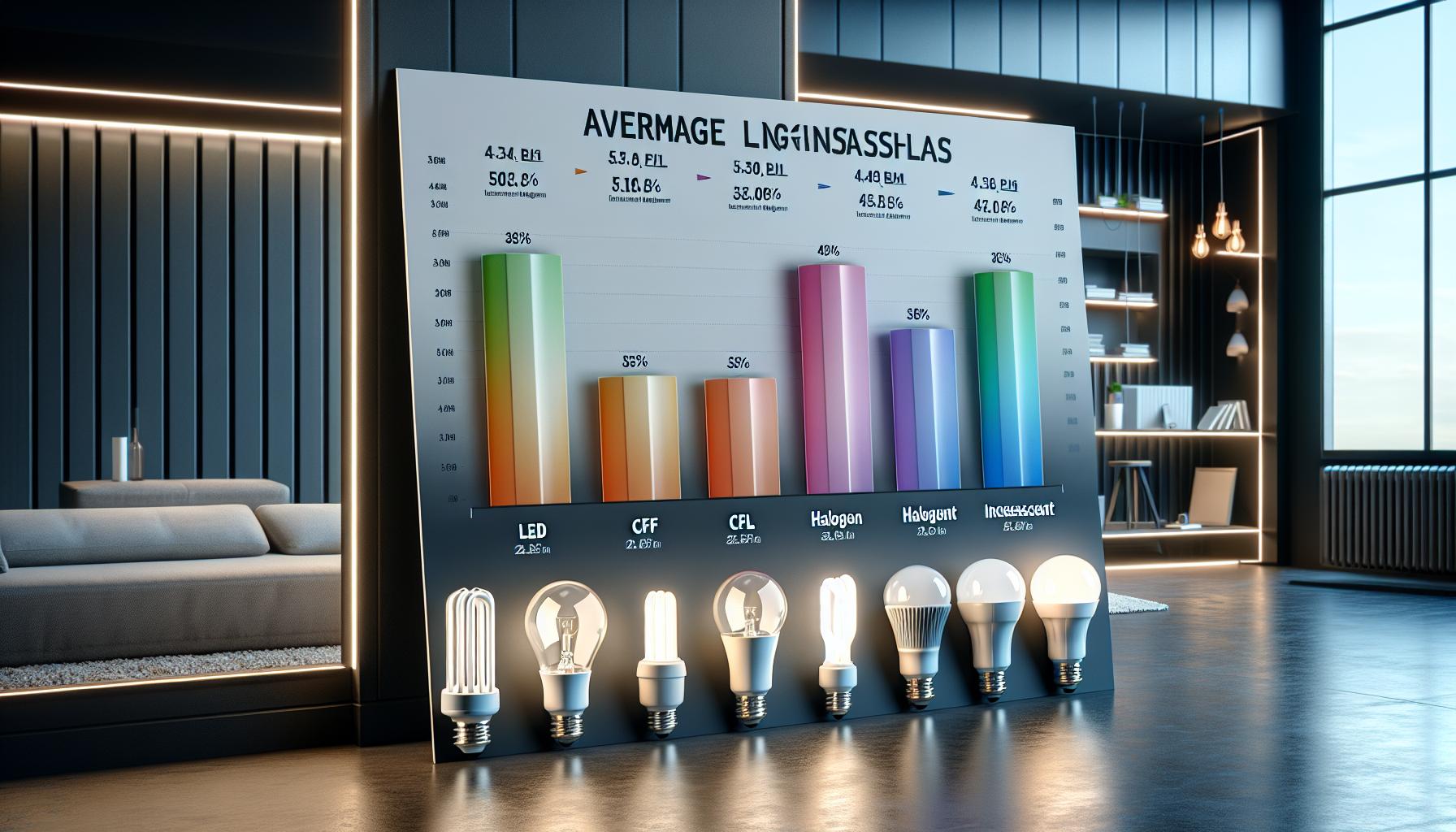Ever found yourself questioning how often you should be swapping out those light bulbs around your house? You’re not alone. It’s a common dilemma that can actually impact both your wallet and your carbon footprint.

Different bulbs boast varying lifespans, and knowing when to replace them can save you from the annoyance of a sudden blackout during your cozy movie night. Let’s shed some light on the subject and keep your home shining bright without any unexpected flickers.
Types of Light Bulbs and Their Lifespans
In the diverse world of artificial lighting, knowing the life expectancy of the bulbs you’re screwing into your fixtures is essential. Grab a ladder and brace yourself for some enlightening facts that’ll keep your living space radiant well into the future.
Incandescent bulbs are the old-school classics. Despite their warm glow, they’re not the stamina champs of the lighting arena. Typically, you’ll be replacing these every 750 to 2,000 hours. If you’re someone who loves the timeless appeal but not the frequent changes, you may want to stock up or consider an alternative.
Halogen bulbs are the more efficient cousins of incandescents, with a bit more endurance. They can last around 2,000 to 4,000 hours. While better, it’s like choosing between running shoes—both will get you to the finish line, but one might need to be swapped out for a new pair a little sooner.
Then you have the current heavyweights of longevity: LED bulbs. You’ll often hear folks rave about these for good reason. LEDs have an impressive lifespan that can range from 15,000 to 25,000 hours. That means less time on the ladder and more time enjoying your well-lit space.
CFLs (compact fluorescent lamps) are another energy-efficient choice. They slot in nicely between halogens and LEDs, shining bright for about 8,000 to 15,000 hours. Not too shabby for a bulb that’s both kind to your electricity bill and your home’s ambiance.
Here’s a quick glance at the average lifespans you can expect:
| Type of Bulb | Average Lifespan (hours) |
|---|---|
| Incandescent | 750 – 2,000 |
| Halogen | 2,000 – 4,000 |
| LED | 15,000 – 25,000 |
| CFL | 8,000 – 15,000 |
Factors that Affect Light Bulb Lifespan
When you’re knee-deep in your DIY home projects, the last thing you want is to be left in the dark—literally. Understanding the factors that influence the lifespan of your light bulbs can mean the difference between timely replacements and unexpected outages. Let’s shed some light on what affects bulb longevity.
Usage and On-Off Cycles: Every time you flip that switch, you’re initiating a cycle that can wear on the bulb’s components. Bulbs in frequently used areas or those with frequent on-off cycles, like your kitchen or living room, might not reach their projected lifespan.
- Power Fluctuations: Inconsistent power supply can play havoc with bulbs, especially incandescent and halogen types. Surges and dips in your home’s electricity can fry or weaken the delicate filaments.
Heat Buildup: Hot environments stress bulbs out. Without proper ventilation or in enclosures that trap heat, bulbs can overheat. For a bulb to live a long, bright life, ensure fixtures allow for adequate air circulation.
Dimmer Compatibility: If you love setting the mood with dimmers, make sure your bulbs can handle the romance. Non-compatible LEDs might flicker or fail early when paired with a conventional dimmer switch.
Quality and Brand: Not all bulbs are born equal. Some come from brands with reputations for durability; others, not so much. Investing in recognized brands often pays off in longevity.
« Why Do Light Bulbs Make a Ringing Sound? Uncover the Surprising Causes
How to Get Light Bulbs to Work in Fallout 4: Illuminate Your Settlement »
Voltage Matching: Using a light bulb with the proper voltage for your fixture is crucial. A mismatch can result in underperformance or a quickly dimmed out bulb.
Remember, your lighting needs are as unique as your DIY projects. Keep these factors in mind, and you’ll find yourself changing bulbs less often, leaving more time for the home improvements you love.
How Long Do Different Light Bulbs Last?
When you’re knee-deep in a DIY project to spruce up your home lighting, the last thing you want is a bulb that fizzles out early. So, it’s smart to get a handle on how long different light bulbs typically last. Lifespan is expressed in hours, and with a touch of planning, you can synchronize your lighting needs with your décor ambitions.
LED bulbs are the long-distance runners in the lighting world. On average, these bulbs can last about 25,000 to 50,000 hours — ideal for those hard-to-reach fixtures you’d rather not scale a ladder for every few months. They may have a higher upfront cost, but their endurance saves you time and money in the long run.
Next up, CFL bulbs, known for their twisty design, offer a lifespan that’s not too shabby either. They’ll light up your space for 8,000 to 15,000 hours. Bonus: Their energy efficiency aligns beautifully with eco-friendly DIY undertakings.
If you’re opting for the warm glow of halogen bulbs, expect them to illuminate your abode for 2,000 to 4,000 hours. Their upfront cost is easier on the wallet, but they’ll join your shopping list more frequently.
Lastly, traditional incandescent bulbs. In the lighting relay, they pass the baton quickly, enduring a modest 750 to 2,000 hours. They may fit the bill for certain aesthetic preferences or light fixtures designed for their specific look.
Take a peek at this handy table summarizing the average lifespans:
| Type of Bulb | Average Lifespan (hours) |
|---|---|
| LED | 25,000 – 50,000 |
| CFL | 8,000 – 15,000 |
| Halogen | 2,000 – 4,000 |
| Incandescent | 750 – 2,000 |
It’s also worth noting that bulbs won’t always reach their maximum lifespan. Usage habits and environmental factors play a vital role — something you’re probably keeping in mind as you work through the various chapters of your home lighting story. Keeping an eye on usage and ensuring your bulbs are properly suited to their fixtures can help nudge them closer to those upper limits of longevity.
Signs that Your Light Bulb Needs Replacing
As you’ve learned about the various lifespans of light bulbs, it’s also crucial to know when it’s time to bid them farewell. Knowing the warning signs can save you from being left in the dark unexpectedly. Here are some telltale signals that a light bulb is on its last filament.
Dimming is one of the first signs a bulb is underperforming. If your room isn’t as brightly lit as it used to be, or if you find yourself squinting even with the lights on, it’s likely time for a change. This is especially true for LED bulbs, as they tend to dim over time rather than burn out abruptly.
Flickering is another common symptom; it’s not just for spooky movie scenes! If your lights are constantly flickering, it could be a sign of a poor connection, but often it’s the bulb’s way of saying, “I’ve almost had it!” But before you replace the bulb, double check that it’s screwed in properly – sometimes that’s all it takes to fix the problem.
If you hear a buzzing sound, it’s not just your imagination. Some light bulbs, particularly older fluorescents or damaged LEDs, can emit an annoying buzz or hum as they near the end of their lifespan.
For bulbs that aren’t meant to be dimmable, if they start to change brightness on their own, it’s a clear signal that there’s an issue. This unpredictable behavior can be due to internal defects or a nearing expiration.
Lastly, look out for visual cues such as black spots or faded glass. These can indicate that the light bulb has been overheating or that it is no longer functioning as efficiently as it should.
Being proactive with bulb maintenance can extend the overall life of your lighting setup. Regularly dust off your bulbs and fixtures to prevent overheating and ensure they’re operating at peak performance. Just remember, consistent signs of wear and tear shouldn’t be ignored – they’re your light bulb’s way of asking for retirement.
Tips for Extending the Lifespan of Light Bulbs
As a connoisseur of illuminating spaces and a devoted DIY enthusiast, you’re well aware of the frustrations that come with replacing bulbs too often. To keep your abode bright and cheery without the hassle of frequent swaps, here are some insider strategies for prolonging the life of your beloved light bulbs:
- Keep It Clean: Dirt and dust can accumulate on bulb surfaces, causing them to overheat. Clean bulbs gently with a dry cloth to ensure maximum efficiency and longevity.
- Switch It Off: This might seem obvious, but turning lights off when leaving a room can significantly expand their lifespan.
Environment plays a pivotal role in the life of your light bulbs:
- Steady Climate: Fluctuating temperatures and humidity can wreak havoc on bulbs. Try to keep your indoor climate as steady as possible.
- Dimmer Compatibility: When using dimmer switches, make sure that your bulbs are compatible. Non-compatible bulbs on a dimmer can have drastically shortened lifespans.
- Avoid Frequent Switching: Constantly turning your lights on and off can reduce the lifespan of your bulbs. If you’ll be back in a room shortly, it might be wiser to leave the light on.
Installation matters as much as usage:
- Secure Fitting: Make sure bulbs are screwed in securely but not too tightly. An over-tightened bulb can cause a build-up of heat, reducing its lifespan.
- Right Size and Wattage: Always use the correct bulb size and wattage for your fixture. Incorrect wattage could cause overheating or electrical issues.
- Quality Counts: Invest in quality bulbs from reputable brands. Higher-quality bulbs might cost more up front but typically last longer and offer better performance.
Remember, keeping an eye on your bulbs’ performance and maintaining them properly doesn’t just save you time and money—it’s also a direct reflection of your commitment to a well-lit, warm, and inviting home.
Conclusion
Remember, taking care of your light bulbs isn’t just about knowing when to replace them—it’s about making sure they last as long as possible. You’ve got some great strategies now to keep your home shining bright without unnecessary replacements. Stick to these habits and you’ll not only save money but also enjoy the warm, welcoming glow of your lights for longer. Happy illuminating!
Frequently Asked Questions
How can cleaning light bulbs extend their lifespan?
Regularly cleaning light bulbs removes dust and dirt that can lead to overheating, thus extending their lifespan.
Is it beneficial to turn off lights every time you leave a room?
Yes, turning off lights when not in use prevents unnecessary energy consumption and reduces wear and tear on bulbs.
Why is maintaining a steady indoor climate important for light bulbs?
A steady indoor climate avoids temperature fluctuations which can cause bulbs to expand and contract, leading to premature failure.
Can dimmer switches affect the lifespan of light bulbs?
Yes, using light bulbs that aren’t compatible with dimmer switches can shorten their lifespan due to inconsistent electrical currents.
How does frequent switching affect light bulb lifespan?
Frequent switching can weaken the bulb’s filament over time, leading to a shorter lifespan.
What’s the significance of proper bulb fitting?
Secure fittings ensure good electrical connections while avoiding excessive stress on the bulb’s components, which can extend bulb lifespan.
Does the size and wattage of a bulb matter for its longevity?
Absolutely, using the correct size and wattage prevents overheating and ensures the bulb operates as designed, thus promoting longer life.
Is investing in quality bulbs worthwhile?
Investing in quality bulbs can be cost-effective in the long run as they tend to have longer lifespans and more reliable performance.




